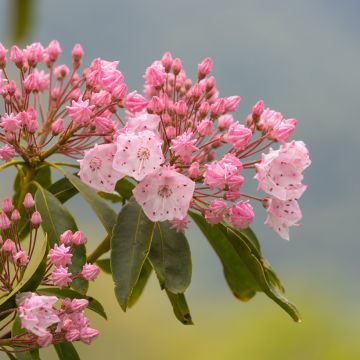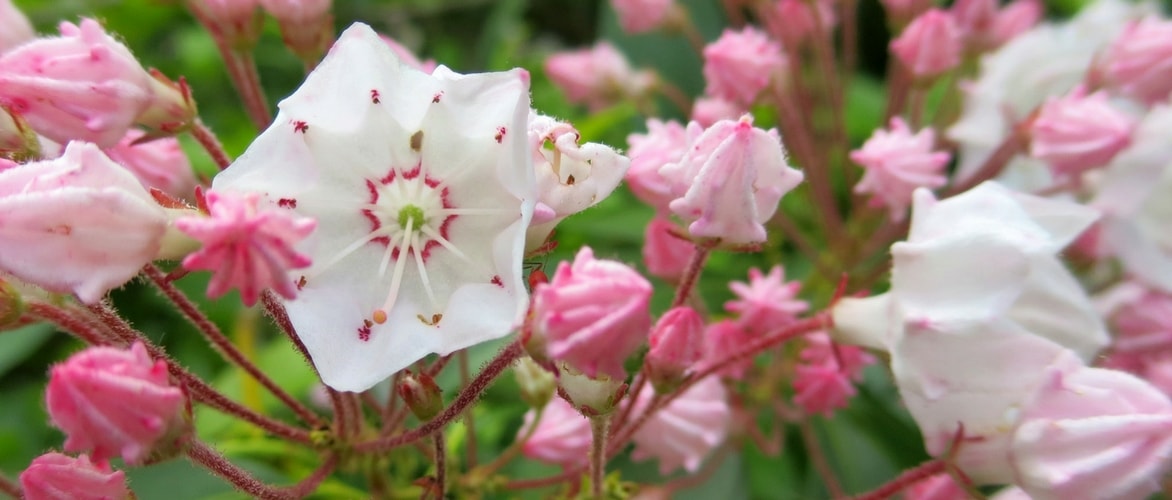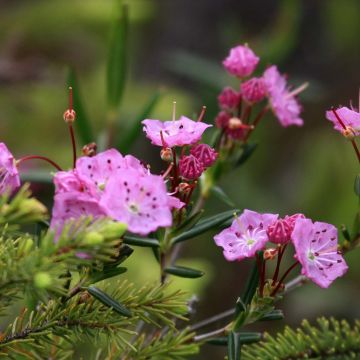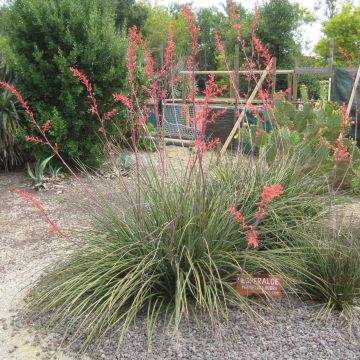

Kalmia angustifolia Rubra - Sheep Laurel


Kalmia angustifolia Rubra - Sheep Laurel
Kalmia angustifolia Rubra - Sheep Laurel
Kalmia angustifolia Rubra
Sheep Laurel, Lambkill, Wicky
Special offer!
Receive a €20 voucher for any order over €90 (excluding delivery costs, credit notes, and plastic-free options)!
1- Add your favorite plants to your cart.
2- Once you have reached €90, confirm your order (you can even choose the delivery date!).
3- As soon as your order is shipped, you will receive an email containing your voucher code, valid for 3 months (90 days).
Your voucher is unique and can only be used once, for any order with a minimum value of €20, excluding delivery costs.
Can be combined with other current offers, non-divisible and non-refundable.
Why not try an alternative variety in stock?
View all →This plant carries a 24 months recovery warranty
More information
We guarantee the quality of our plants for a full growing cycle, and will replace at our expense any plant that fails to recover under normal climatic and planting conditions.
Would this plant suit my garden?
Set up your Plantfit profile →
Description
The Kalmia latifolia 'Rubra' is a charming variety of bush laurel, compact, bushy, and very floriferous, with an intense colour. Its large slightly incurved corollas, grouped in terminal clusters, display a dark pink hue with bluish reflections, blending with the geometrically shaped pink floral buds. Of modest size, this bush easily finds its place in a large pot or in a small garden. It is cultivated similarly to rhododendron, in partial shade, in heather soil, always kept slightly moist.
The Kalmia latifolia 'Rubra' belongs to the Ericaceae family, like Heather and Rhododendron. This slow-growing bush reaches about 80 cm in height and 1 m in spread by the age of 10. Its well-branched trunk gives it a bushy, compact, and somewhat erect habit, generally becoming a little wider than tall with age. Its evergreen foliage in winter, medium green with a lighter underside, ensures decorative interest all year round. The leaves are tough and thick with a slightly V-shaped form. The show is at its peak in late spring, in June-July, when it is covered with its unique flowers. Their waxy texture brings out the original patterns drawn on the petals. Each branch bears terminal clusters with an abundance of ribbed pink buds opening into dark pink flowers with bluish reflections. They are very wide, becoming almost flat at maturity and measuring up to 5 cm in diameter. After flowering, if they have not fallen, the flowers give way to brown capsule-shaped fruits, persistent in winter.
Kalmias, unfairly overlooked, offer an enchanted flowering. These hardy heather soil bushes flourish in partial shade in moist to wet soil rich in humus. The 'Rubra' Kalmia is ideal for enhancing your other heather soil plants, such as Hydrangeas, Japanese maples, camellias, or even rhododendrons. Thanks to its compact growth, it is also suitable for container cultivation on balconies or terraces, provided the soil is kept consistently moist and non-calcareous water is used for watering.
Kalmia latifolia is a bush whose all parts (leaves, flowers, fruits, roots) are toxic, to humans as well as animals (dogs, cats, sheep, horses), in case of ingestion.
Kalmia angustifolia Rubra - Sheep Laurel in pictures




Plant habit
Flowering
Foliage
Botanical data
Kalmia
angustifolia
Rubra
Ericaceae
Sheep Laurel, Lambkill, Wicky
Cultivar or hybrid
Other Kalmias
View all →Planting and care
The Kalmia latifolia 'Rubra' is extremely hardy and can withstand very low temperatures, down to -20°C. It should be placed in a semi-shaded position, in a humus-bearing and fertile, acidic (no limestone), moist (even damp) soil. For planting, avoid periods of frost or extreme heat, but rather favour those of spring or autumn rains, which will facilitate its establishment. Plan for a wide and deep pit (50 cm by 50 cm) so that your Kalmia can settle in permanently. If the soil is limestone, it will be necessary to replace it entirely with a mixture of heather soil, leaf compost and turf in a large planting pit. Regular watering (with rainwater if possible) in the first weeks following planting is necessary to keep the soil moist and fresh. A mulch of bark chips at the base can be beneficial to protect the fine and surface roots.
Every spring, loosen the soil around the base and surface with a mix of compost, heather soil and mulch. Mountain laurel dreads scorching situations and heatwaves. It must be placed in such a way that it is shaded during the hottest hours of the day. During the summer and especially in case of drought, ensure regular watering (preferably with rainwater). This summer watering is particularly important as floral buds form for the following spring. Loving coolness and good humidity, mountain laurel will thrive in an oceanic or rainy climate. With its small growth, it is well suited for container cultivation on a terrace or balcony. The risks of soil drying out are higher in container cultivation, so a large container and increased monitoring of watering will be essential.
Planting period
Intended location
Care
Planting & care advice
This item has not been reviewed yet - be the first to leave a review about it.
Similar products
Haven't found what you were looking for?
Hardiness is the lowest winter temperature a plant can endure without suffering serious damage or even dying. However, hardiness is affected by location (a sheltered area, such as a patio), protection (winter cover) and soil type (hardiness is improved by well-drained soil).

Photo Sharing Terms & Conditions
In order to encourage gardeners to interact and share their experiences, Promesse de fleurs offers various media enabling content to be uploaded onto its Site - in particular via the ‘Photo sharing’ module.
The User agrees to refrain from:
- Posting any content that is illegal, prejudicial, insulting, racist, inciteful to hatred, revisionist, contrary to public decency, that infringes on privacy or on the privacy rights of third parties, in particular the publicity rights of persons and goods, intellectual property rights, or the right to privacy.
- Submitting content on behalf of a third party;
- Impersonate the identity of a third party and/or publish any personal information about a third party;
In general, the User undertakes to refrain from any unethical behaviour.
All Content (in particular text, comments, files, images, photos, videos, creative works, etc.), which may be subject to property or intellectual property rights, image or other private rights, shall remain the property of the User, subject to the limited rights granted by the terms of the licence granted by Promesse de fleurs as stated below. Users are at liberty to publish or not to publish such Content on the Site, notably via the ‘Photo Sharing’ facility, and accept that this Content shall be made public and freely accessible, notably on the Internet.
Users further acknowledge, undertake to have ,and guarantee that they hold all necessary rights and permissions to publish such material on the Site, in particular with regard to the legislation in force pertaining to any privacy, property, intellectual property, image, or contractual rights, or rights of any other nature. By publishing such Content on the Site, Users acknowledge accepting full liability as publishers of the Content within the meaning of the law, and grant Promesse de fleurs, free of charge, an inclusive, worldwide licence for the said Content for the entire duration of its publication, including all reproduction, representation, up/downloading, displaying, performing, transmission, and storage rights.
Users also grant permission for their name to be linked to the Content and accept that this link may not always be made available.
By engaging in posting material, Users consent to their Content becoming automatically accessible on the Internet, in particular on other sites and/or blogs and/or web pages of the Promesse de fleurs site, including in particular social pages and the Promesse de fleurs catalogue.
Users may secure the removal of entrusted content free of charge by issuing a simple request via our contact form.
The flowering period indicated on our website applies to countries and regions located in USDA zone 8 (France, the United Kingdom, Ireland, the Netherlands, etc.)
It will vary according to where you live:
- In zones 9 to 10 (Italy, Spain, Greece, etc.), flowering will occur about 2 to 4 weeks earlier.
- In zones 6 to 7 (Germany, Poland, Slovenia, and lower mountainous regions), flowering will be delayed by 2 to 3 weeks.
- In zone 5 (Central Europe, Scandinavia), blooming will be delayed by 3 to 5 weeks.
In temperate climates, pruning of spring-flowering shrubs (forsythia, spireas, etc.) should be done just after flowering.
Pruning of summer-flowering shrubs (Indian Lilac, Perovskia, etc.) can be done in winter or spring.
In cold regions as well as with frost-sensitive plants, avoid pruning too early when severe frosts may still occur.
The planting period indicated on our website applies to countries and regions located in USDA zone 8 (France, United Kingdom, Ireland, Netherlands).
It will vary according to where you live:
- In Mediterranean zones (Marseille, Madrid, Milan, etc.), autumn and winter are the best planting periods.
- In continental zones (Strasbourg, Munich, Vienna, etc.), delay planting by 2 to 3 weeks in spring and bring it forward by 2 to 4 weeks in autumn.
- In mountainous regions (the Alps, Pyrenees, Carpathians, etc.), it is best to plant in late spring (May-June) or late summer (August-September).
The harvesting period indicated on our website applies to countries and regions in USDA zone 8 (France, England, Ireland, the Netherlands).
In colder areas (Scandinavia, Poland, Austria...) fruit and vegetable harvests are likely to be delayed by 3-4 weeks.
In warmer areas (Italy, Spain, Greece, etc.), harvesting will probably take place earlier, depending on weather conditions.
The sowing periods indicated on our website apply to countries and regions within USDA Zone 8 (France, UK, Ireland, Netherlands).
In colder areas (Scandinavia, Poland, Austria...), delay any outdoor sowing by 3-4 weeks, or sow under glass.
In warmer climes (Italy, Spain, Greece, etc.), bring outdoor sowing forward by a few weeks.


























































